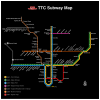Hi everybody, I'll like to submit my proposal for all those wonderful fantastical transit maps out there.
Procedural Points:
-Lines 1, 2, 3, and 4 are subway lines
-Lines 5, 6, 7, 8, 9, and 10 are LRT lines
-A total of 10 lines, including the Hurontario Line because the Bloor-Danforth, Eglinton, Finch and Waterfront Lines would be extended into Peel Region
-Some GO station names are changed to accommodate more prominent station locations that are better suited with the older GO station name
-Eglinton GO station is changed to Cedarbrae because of the more prominent existing Eglinton station on the University Line/Eglinton Line
-Brampton GO station is changed to Rosalea because Brampton City Centre should take precedent and is a more important location
Greater Transportation:
-Pearson Airport would be serviced by the Finch Line, Eglinton Line, and Queen line (DRL)
-Billy Bishop Airport is serviced by the Lakeshore-Kingston Line at Eireann Station
-Jack Layton Ferry Terminal is serviced by the Lakeshore-Kingston Line
Education:
-The two satellite University of Toronto campuses, Scarborough and Mississauga, are now connected on each ends of the Eglinton Line
-All three UofT campuses are connected by rapid transit
-The two Toronto-located Humber College campuses, North and Lakeshore, are connected by the Finch and Lakeshore-Kingston Lines, respectively
Entertainment:
-Canada's Wonderland is serviced by the Yonge-University Line
-Toronto Zoo is serviced by the Sheppard East Line
-BMO Place is serviced by the Lakeshore-Kingston Line
-Molson Amphitheatre/Ontario Place is serviced by the Lakeshore-Kingston Line
-Exhibition Place is serviced by the Lakeshore-Kingston Line
-Woodbine Racetrack is serviced by the Finch Line
-Sherway Gardens is serviced by the Bloor-Danforth Line
-CN Tower, Rogers Centre, and Ripley's Aquarium are a 5 minute walk from Rees station on the Lakeshore-Kingston Line
-Distillery District is a 2 minute walk from Parliament or Cherry stations on the Lakeshore-Kingston Line
Politics:
-To the detriment of Councillors Matlow and Ainslie and the satisfaction of Mayor Tory, a Line 2 subway extension would be built to better shuffle all the people coming from the Eglinton and Sheppard East Lines to and from downtown
-To the detriment of almost all the Brampton Councillors and the satisfaction of Mayor Jeffrey, the Hurontario Line would be extended into Brampton along Main Street
-To the satisfaction of Councillor Di Ciano, Bloor-Danforth will be extended to Sherway Gardens
-To the detriment of Councillor Karygiannis, the Sheppard LRT would be built instead of a subway











